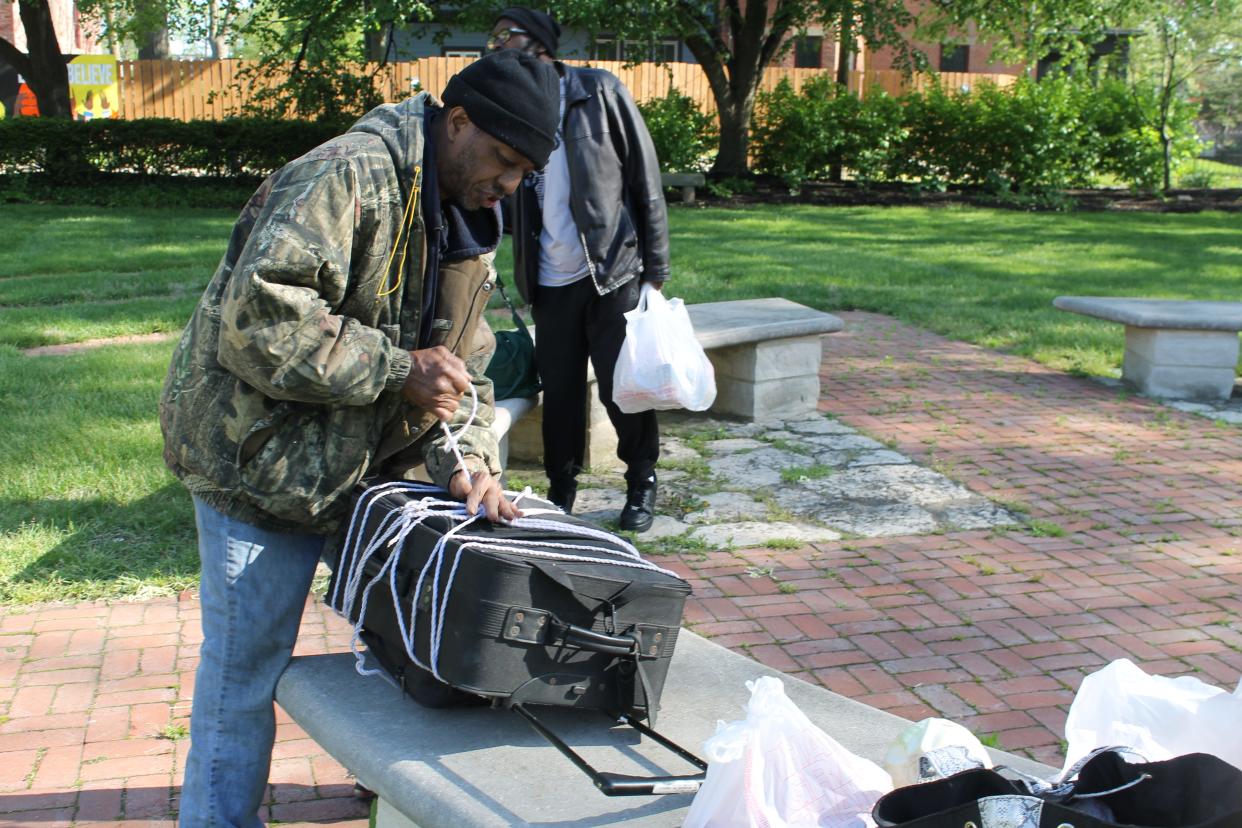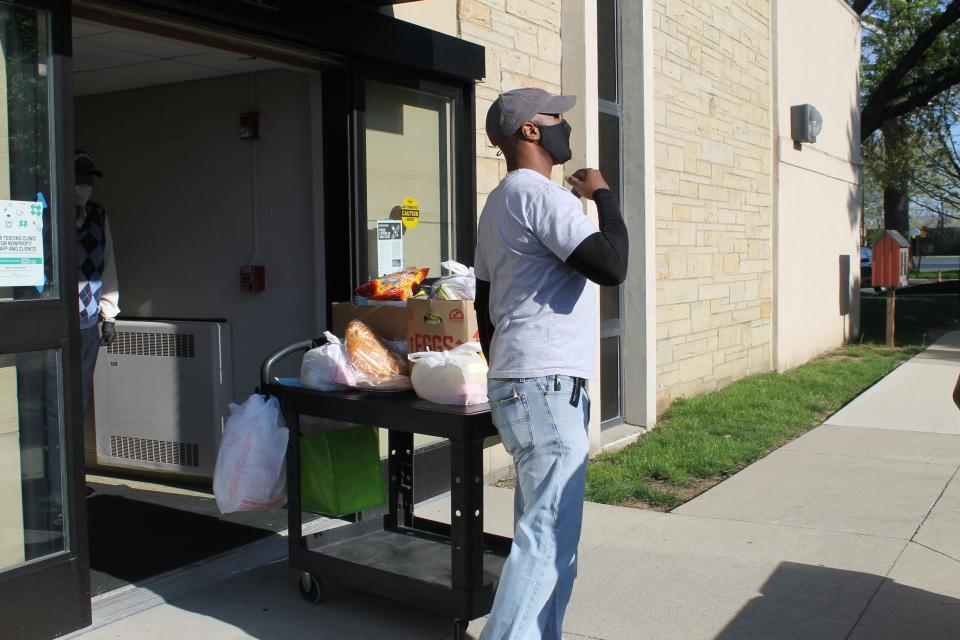700,000 low-income Ohio households could see big cuts to food stamps program in July

On a Monday morning, cars line up at the Broad Street Presbyterian Church outside downtown Columbus waiting to pick up items from its food pantry.
Demetric Blankenship and Orville Sharp III, however, do not have the luxury of a vehicle, having arrived by foot or bus. They take their portions to a small park outside the church entrance, surveying what they got and packing them into whatever bags they can carry.
Blankenship frantically searched through his items, but there was one thing he didn't see. "You got any more meat?" he shouted at Sharp.
"They only gave me one, that's all I got," Sharp answered back.
Both food banks and low-income Ohioans are struggling to obtain fresh and healthy foods as food prices soar, due to labor shortages and supply chain disruptions caused by COVID-19. The pandemic also worsened food insecurity in Ohio, with 334,000 more people served by pantries this March than two years ago.
Some fear it could get worse.
When the federal government potentially ends its COVID-19 emergency declaration in July, significant boosts to Supplemental Nutrition Assistance Program benefits, or food stamps, will also disappear for at least 700,000 Ohio households.
More people are expected to start showing up at food pantries this summer. Food banks, which are seeking more state money to help, may have to turn people away.
"All hell's going to break loose," said Lisa Hamler-Fugitt, executive director of the Ohio Association of Foodbanks.
Food stamp benefits boosted during pandemic
Around $120 million per month in federal funds has boosted food stamps in Ohio since the government authorized large increases at the beginning of the pandemic, when COVID-19 orders had shut down businesses and millions of jobs were lost.
Sharp said before the pandemic, he was individually getting above $180 a month. Now, he's getting around $260. That's in line with the roughly $100 average increase in SNAP benefit per person across the U.S.

Certain households, such as ones with older adults, saw hundreds of dollars in increases. An older adult living alone might have received $16 monthly in 2019, but during the pandemic, got $234 monthly. It's a reality many have lived with for the past two years.
The sudden reversion to pre-pandemic levels may force hard budgeting adjustments and catch many recipients off-guard, like it did with Blankenship, who was unaware of the potential change.
"They should have communicated to us more and let us know that we're the ones that got to suffer," he said of the government.
Advocates against hunger praised the increased benefits and have long said food stamp amounts were never enough. They point to studies and data that showed SNAP and other nutritional aid prevented a much worse hunger situation during the pandemic.
Not everybody is convinced. A dozen other states, mostly Republican-led, have withdrawn from the SNAP enhancements early, citing the need to move on from the pandemic and get people back to work.
"We're in the stage now where the generosity of the federal government pumping money and sending it out is contributing to the inflation and high prices," said Rea Hederman with the Buckeye Institute, a conservative think tank. He did not take a position on whether Ohio should have withdrawn as well.
Gov. Mike DeWine's administration has stuck with the enhanced SNAP portion (which is 100% federally funded) and seems likely to continue to do so.
Multiple people picking up food at the Broad Street church were thankful for the increases in benefits, saying they'll take what they can get. But even with the boosted benefits, they were still at the pantry for a reason.
"It's never enough," said Sharp. "If it was just for me, I'd be alright. But I got a big family."

On-the-ground impact
Many Ohioans have seen their food stamps buy fewer items at the grocery store as inflation increases. Healthier foods are particularly more expensive.
"I really can't afford much. They say I'm supposed to have a special diabetic diet, and I can't afford that," said Carol Haag, as she loaded food into a shopping cart she brought to the pantry. "I can't afford to eat vegetables or have protein because everything is so high."
She said she's also facing pressure from higher rent, and if other living costs start increasing, she may have to use part of her Social Security money to pay for food.
Sharp said he adjusted to the higher prices by acquiring more canned or boxed goods that have longer shelf lives and can be spread out over longer periods of times. Others say they have simply skipped meals.
"Sometimes I'd rather not eat," said Blankenship, who said he has kidney disease and wants to avoid cheaper fried foods as much as possible.
That's why many have turned to food banks to access healthy foods, but even that option may not last. Donations and volunteers have declined. Securing food, especially meat, is exponentially harder and more expensive.
Food pantries and inflation: Food pantries in Ohio, Greater Columbus struggle to feed hungry amid surging inflation
When asked what they would do when their food stamps got cut, many at the pantry said they'd have to hit food pantries even more. But Hamler-Fugitt, with the Ohio Association of Foodbanks, is not so sure.
"Once these cuts go into effect, we'll just ration food," she said. "That's all we can do. We'll ration food. And the smaller food banks are already cutting back."
Ohio food banks want state help
To prepare for the end of the COVID-19 emergency, Hamler-Fugitt said her group is asking the state for $183 million from its portion of the American Rescue Plan Act. Around $50 million of that is needed now to help with immediate issues food banks are currently facing.
A good amount would go toward buying food to make up for lost donations and decreased food supply. Other investments include hiring staff, purchasing vehicles for food delivery, expanding warehouses and buying equipment.
Hamler-Fugitt said she reached out to the DeWine administration in October and is providing updates. Talks with lawmakers are also ongoing.
"We are going to do everything in our power to serve the people that are turning to us, but currently, we cannot replace $120 million worth of lost SNAP benefits," she said.
The Office of Budget and Management said any American Rescue Plan Act requests are still under review and would need the state legislature to act on them. Rep. Scott Oelslager of North Canton, who chairs the Ohio House Finance Committee, said he's aware of the request but could not say if anything will happen before the summer.
"That will be one of the issues we will deal with once we see where we are and once we see where the money is coming in," he said.
On the federal level, President Joe Biden's administration last year permanently increased SNAP benefits by its largest amount ever by over 25%. That means cuts won't be as huge when the emergency ends. Legislation in Congress could further expand the program's reach.
The best case scenario, said Hamler-Fugitt, is if the COVID-19 emergency is extended again beyond July so extra benefit allotments are kept in place.
But for those relying on food stamps, they said they can't think too much about the future. Food has to be put on the table now.
"We're just trying to survive," Blankenship said.
Titus Wu is a reporter for the USA TODAY Network Ohio Bureau, which serves the Columbus Dispatch, Cincinnati Enquirer, Akron Beacon Journal and 18 other affiliated news organizations across Ohio.
This article originally appeared on The Columbus Dispatch: SNAP benefits: Ohio families facing cuts as COVID benefit boost ends

